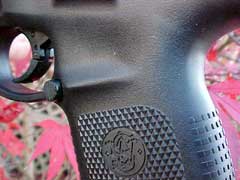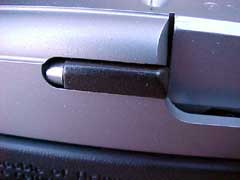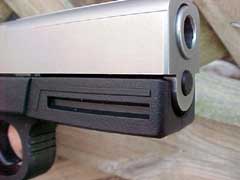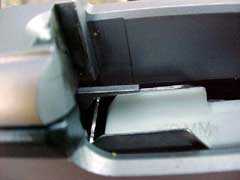|
The Wondernine is back. Not that it really went anywhere, much to the
dismay of those who tried to deal it a death blow in 1994 by including a
magazine capacity limit on weapons in the now defunct "Assault Weapons
Ban". The standard capacity magazines just got more expensive and
harder to find. Many in our government, including our illustrious
Pervert in Chief at the time, William Jefferson Clinton, celebrated
the passage of that useless piece of legislation as the first step in
taking away the rights of citizens to own and carry handguns.
Ten years later, we have a Congress that
recognizes that the citizens of this country do not want any of
our inalienable rights alienated. The weapons ban went away,
along with the ban on standard capacity magazines. Some people
just donít get it. The second amendment to our Constitution
has nothing to do with hunting, or even concealed carry. It is
there to guarantee that all of our other rights will not be
infringed. It does not protect us from a deer, duck, or even a
home intruder. The second amendment exists to assure that our
rights will not be infringed by our government. Many in our
government make a career out of infringing our rights, on a
daily basis. Anyway, it took ten years, but we finally got back
that little piece of ground, and pistols are again available
with their intended magazine capacity.
The term "Wondernine" came into use
with the introduction of an influx of high tech, reliable auto
pistols that were chambered for the 9mm Luger cartridge, and
that held over a dozen rounds in their respective magazines.
This was around three decades ago, and much debate arose
regarding the pistols and the cartridge for which they were
chambered. Many found the 9mm Luger cartridge lacking for social
work, but law enforcement, military, and private citizens took
to the concept of the pistol in droves. Before the
introduction of the Wondernines, most police officers carried
six-shot revolvers, which were very good guns for the purpose,
but many were looking for more firepower, and the new 9mm auto
pistols were widely adopted. At that time, however, ammunition
technology was somewhat lacking, with the exception of a
few pioneering companies such as Super-Vel. The fact was
that most 9mm ammunition at that time was not up to the task of
quickly stopping criminal action.
Today, that has changed, and we have much better
ammunition than what was generally available thirty years ago.
Most of the major ammunition companies now make some very good
anti-personnel 9mm ammo. I like the idea of a compact, yet
controllable 9mm auto pistol. I like the fact that with between
fifteen and eighteen rounds in the pistol, I seldom see the need
to carry a spare magazine. I usually carry a five-shot S&W
revolver everywhere that I go, but there are certain places that
I sometimes have to visit that I feel the need to carry bigger
ordnance. At those times, I generally carry a 1911 style .45
auto with a couple of spare magazines, or a sixteen shot 9mm
auto, sometimes also with extra magazines, just in case. I like
the power of the .45, but I never feel under-gunned with the
nine. Modern high performance 9mm ammunition is built
specifically for the task of personal defense, and it works
quite well. With todayís modern high performance ammunition,
the Wondernine is better than ever.
I recently received for testing a new Smith
& Wesson Sigma 9mm auto pistol, which fits neatly into
the definition of a Wondernine. The Sigma is S&Wís answer
to the Glock, which is
one of the most successful auto pistols in the world. The early
Sigmas had a few problems when introduced several years ago, but
Smith & Wesson has addressed those problems, and the new
Sigma is definitely a better pistol than those earlier guns.
Upon opening the familiar blue plastic case, I was delighted to
see that the new Sigma comes supplied with two sixteen-round
magazines. The magazine bodies are also made of stainless steel,
for many years of durability. Those who have handled a Sigma
already know that the similarities between it and the Glock are
obvious, and comparisons between the guns are inevitable, so
letís do it.
The action on the S&W is very much like the
Glock. Both are striker fired, and must be reset by the slide
after each pull of the trigger. Both guns are built on the
modified Browning short recoil system, in which the slide
and barrel are locked together upon firing briefly, and are
unlocked by the rear of the barrel tilting downward, releasing
the slide to travel rearward, ejecting the empty case, and
returning into battery under the power of the recoil spring,
chambering a round from the magazine in the process. Both
the Smith and the Glock wear no external safety levers, except
for the safety integrated into the trigger itself, which must be
deliberately pulled to fire the weapon. Both pistols have
internal firing pin blocks, to prevent firing unless the trigger
is held rearward. Both guns use a double stack magazine which,
depending upon the exact model, carries between fifteen and
seventeen rounds of 9mm Luger ammunition. Both guns have a
plastic frame, with a slide that is removed by pressing downward
on two catches on either side of the frame, just above the
trigger guard. Both guns have three dot sights as standard
equipment. If you are familiar with the Glock manual of arms,
the Sigma will feel right at home. Noticeable differences
include the magazines. Glock uses a plastic mag body, while the
S&W uses a stainless body. Also, the magazine catch, which
locks the magazine into the frame, is steel on the Smith and
plastic on the Glock. The trigger safety differs a bit on the
two weapons, and there are subtle but important differences in
the grip area of the pistols. The S&W seems more ergonomic.
In other words, it just feels better, at least to my hand. The
closest member of the Glock family to the Smith & Wesson is
their model 19. Therefore, for comparison, I will list a few
critical measurements below:
| |
S&W Sigma |
Glock Model 19 |
| Barrel length |
4 inches |
4 inches |
| Weight, empty |
21.4 ounces |
21.1 ounces |
| Trigger pull |
9.1 pounds |
5.2 pounds |
| Magazine Capacity |
16 rounds |
15 rounds |
| Overall length |
7.125 inches |
7 inches |
| Slide width |
1 inch |
1.05 inches |
| Height |
5.375 inches |
5 inches |
| Trigger reach |
2.67 inches |
2.845 inches |
| Grip thickness at web |
1.092 inches |
1.168 inches |
| Grip thickness at palm |
1.228 inches |
1.154 inches |
These are the objective measurements, which shows that the two pistols are
very close in critical dimensions. The Glock does have a lighter trigger
pull, which is smooth and even on both guns. Some people prefer heavier
trigger pulls, but I like them lighter. The S&W grip feels better to my
hand, having a thinner web area and a slight palm swell. Both guns have
textured grip panels, and the Smith has a slight thumb rest on each side.
Both guns have heavy duty spring loaded extractors and fixed blade
ejectors. Objectively, the guns are very close. Subjectively, I like
the feel of the Smith better, except for the heavier trigger pull, which
can most likely be lightened by a good gunsmith, as I have had done to my
Glock model 19. This is enough of the comparisons between the Glock
and the Smith & Wesson, except for one important difference, which I
will save for later.
The most important factor in evaluating any personal defense weapon is
reliability, with accuracy secondary. For evaluating the new Sigma, I
assembled a variety of high performance 9mm ammunition. All loads tested
were of hollowpoint design, except for some excellent Geco ball ammo
that I always like to include in any 9mm pistol test. While the majority of
defensive pistol scenarios are best served by a good hollowpoint,
occasionally a barricade must be penetrated. The best penetrating 9mm round
available to my knowledge is the Geco ball cartridge. Every brand and type
of ammunition tested functioned perfectly in the Sigma. There were no
failures of any kind. Accuracy was also good for a defensive pistol of its
type. The Sigma would keep a full magazine of ammo inside the kill zone of
a standard silhouette target at 25 yards, rapid fire. From a rested
position, most ammo would group just under three inches at the same range.
This is good combat accuracy.
While every type of ammo tested worked perfectly, I really like the
performance of the Cor-Bon PowRBall. The
PowRBall is a 100 grain polymer tipped hollowpoint that screams out of the
Smithís four inch barrel at an average of 1572 feet per second as
recorded on my PACT chronograph, set up at twelve feet from the
muzzle. This is almost 100 feet per second faster than the advertised
velocity of 1475. I have tested the PowRBall ammo before, and have a deep
respect for the terminal performance of this bullet.
The new Smith & Wesson SW9VE is a reliable weapon that is well suited
for personal defense or police work. It is accurate enough to fulfill its
intended purpose, and feels great in my hand, and to those others that
tried the weapon. The last great thing about this pistol is its price. The
suggested retail is just $369, but I have seen this gun retail for around
280 bucks. That is about half the price of a new Glock. The Smith comes
with two magazines, a lockable hard plastic case, instruction manual, a
cable lock, and Smith & Wessonís lifetime warranty.
Check them out online at: www.smith-wesson.com.
To purchase Cor-Bon PowRBall ammo online, go to: www.cor-bon.com.
Jeff Quinn
  
Got something to say about this article? Want to agree (or
disagree) with it? Click the following link to go to the GUNBlast Feedback Page.
All content © 2004 GunBlast.com.
All rights reserved. |
|
Click pictures for a larger version.

Smith & Wesson's new Sigma "Wondernine".


The very affordable retail price of the S&W Sigma
includes a plastic case, lock, manual, and two stainless steel
16-round magazines.

S&W's Sigma 9mm compares very favorably with its
natural competition, Glock's Model 19, and at about half the
price.


The new Sigma features a very comfortable and
well-thought-out grip design.


Sights are snag-free and of the popular
"three-dot" configuration, with drift-adjustable
rear sight.








The S&W Sigma features (top to bottom): chamber
witness hole, spring-loaded extractor, trigger pivot safety,
integral accessory rail, Glock-style takedown latch,
full-length composite guide rod, fixed blade ejector, and
flat-coil recoil spring.

Internal lockwork is simple, rugged and reliable.

The 100% reliability of the test gun is due in part to
S&W's design of the feeding system. Cartridges in the
magazine are perfectly aligned for straight-line feeding into
the chamber.


The S&W Sigma performed superbly with a wide variety
of ammunition. Jeff's favorite 9mm load, Cor-Bon's PowRBall,
really stood out from the crowd with perfect reliability, good
accuracy, and velocity almost 100 feet per second above
advertised velocity.

With its excellent ergonomics, reliability, combat-level
accuracy, and 17-round capacity, the Smith & Wesson Sigma
9mm truly heralds the "return of the Wondernine"!
|
![]()